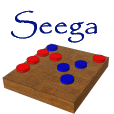| |
DataScenes Mobile Apps - Sabiya Seega
Comment on this using Twitter:
 Seega is a game whose origins are quite lost. It is probably the ancestor of a series of
similar games which spread northwards, changing its name as it did so. The Greek version
was called petteia, the Roman one Latrunculus, and northern Europeans such as the Vikings
called it Hnefatafl. The specific details of board size and gameplay vary, but these games
all share key features such as the movement style, and especially the capture method of
trapping the enemy piece between two of your own pieces. The Greeks said that petteia had
been learned in Egypt, though solid evidence for this is lacking. Several game board markings
in the city of Petra have been interpreted as suitable for playing Seega, but this is only one
among several possibilities. The game is still played in parts of North Africa.
Seega is a game whose origins are quite lost. It is probably the ancestor of a series of
similar games which spread northwards, changing its name as it did so. The Greek version
was called petteia, the Roman one Latrunculus, and northern Europeans such as the Vikings
called it Hnefatafl. The specific details of board size and gameplay vary, but these games
all share key features such as the movement style, and especially the capture method of
trapping the enemy piece between two of your own pieces. The Greeks said that petteia had
been learned in Egypt, though solid evidence for this is lacking. Several game board markings
in the city of Petra have been interpreted as suitable for playing Seega, but this is only one
among several possibilities. The game is still played in parts of North Africa.
The game consists of two separate phases - a placement phase in which players take turns to
position their pieces on the board, and a contest phase in which the pieces are moved in order
to capture enemy counters. A game can be won in two main ways - either one side is reduced to
a single counter, or else a barrier across the board is completed and one side has more
pieces than the other. It is quite common for games to be drawn.
During the placement phase, a game option allows pieces to be placed singly or in pairs. The
central square must remain empty at this time. When all pieces have been placed, the contest
phase starts.
During the contest phase, players take turns to move a single piece. A basic move consists of
one step along the main play axes - left, right, up or down. Pieces cannot move diagonally,
nor can they jump over an adjacent piece. If the result of this move is to trap an enemy
piece between two of your own pieces, then that enemy piece is captured and removed from
the board. A single move can result in up to three captures. When the move has finished, the
turn passes to the other player.
Just as for most games from the ancient world, we cannot be sure of the exact rules used, let
alone all the local variations that must have existed. To reflect this, lots of game options
are offered so that individual players can tailor the game - and the strategy used by their
opponent - to suit their own preferences
Your AI opponent is called `Sabiya`, which means `child of metal` in Egyptian – I hope you find
Sabiya`s various strategies and choices something of a challenge.
Available from:
|
|